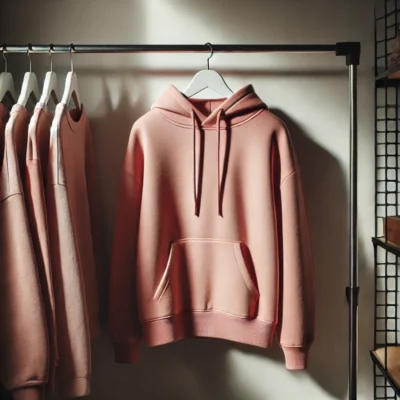Hoodie Material Explained: How to Choose the Right Hoodie Fabric?
Ever bought a hoodie that looked great but felt either too stiff, too thin, or just… off? That’s probably because of the hoodie material, and yes, it matters more than you think. The right fabric doesn’t just affect how it feels on your skin, but also how warm it keeps you, how long it lasts, and how well it suits your daily life.
Whether you’re lounging at home, heading to the gym, or braving chilly mornings, this guide will help you choose the best hoodie material based on what matters most: warmth, breathability, durability, and your intended use, from casual wear to outdoor adventures. Let’s break it all down so your next hoodie is your best one yet.
What Is Hoodie Material?
Hoodie material refers to the type of fabric used to make a hoodie, and it’s a key factor in how the hoodie feels, performs, and lasts. It might sound like a small detail, but the fabric can completely change your experience, whether you want a hoodie that’s breathable for workouts, warm for winter, or soft enough to live in every day.
So, what makes a good hoodie material? First, softness—no one wants to wear something scratchy or stiff. Then there’s thickness, which affects warmth and structure. You’ll also want flexibility, especially if you’re moving around or layering multiple pieces. And don’t forget insulation—materials like fleece or wool blends trap heat, making them ideal for cold weather. Choosing the right fabric means comfort, performance, and longevity all in one.
The 8 Most Common Hoodie Fabrics
When it comes to hoodies, the material makes all the difference, not just in terms of comfort, but also in terms of warmth, durability, and style.
Cotton
Cotton is a classic hoodie fabric that many people love for its natural softness and breathability. Its soft texture makes it an ideal choice for daily comfort and easygoing activities where breathability matters.
Because it’s a natural fiber, cotton allows air to flow easily, keeping you comfortable. However, cotton hoodies may shrink or fade a bit after washing, so they need some care to keep them looking fresh over time.
Fleece
Fleece stands out for its thick, velvety feel that traps heat, keeping you snug even in chilly weather.
Often made from polyester or blended with cotton, fleece hoodies are a go-to choice when temperatures drop. The fabric traps heat effectively while remaining lightweight, making it ideal for outdoor activities or just relaxing on cold days.
Plus, fleece dries quickly and is easy to clean, which adds to its convenience.
Cotton-Polyester Blends
Blending cotton with polyester creates a fabric that balances comfort and durability. These hoodies tend to keep their shape better than pure cotton and resist shrinking in the wash.
Polyester in the blend moves sweat away from your skin, while cotton provides a natural, comfortable softness. This blend works well for versatile wear, from casual outings to moderate exercise, throughout the year.
French Terry
French Terry is characterized by a sleek outer layer paired with a looped, textured interior that enhances breathability and comfort. This unique texture provides moderate warmth and excellent breathability, making it a favorite for athletic wear and mild weather.
The fabric’s moisture-wicking properties help keep you dry during workouts, and its lightweight feel makes it easy to move around in.
Wool
Wool is a natural insulator that offers great warmth and is naturally water-resistant, making it a strong choice for extreme cold conditions.
Wool hoodies tend to be thicker and more durable, but they can sometimes feel itchy if not blended with softer fibers. For those who want a heavy-duty winter hoodie, wool or wool blends provide unmatched protection against the cold.
Jersey Knit
Jersey knit is a lightweight, stretchy fabric that’s great for layering or casual active wear. It’s soft and flexible, allowing for easy movement.
While jersey knit hoodies aren’t designed to provide much warmth, their breathability and comfort make them popular for mild weather or as an under layer.
Nylon
Nylon is less common for hoodies but is often used in blends to add water resistance and durability. Its smooth, shiny finish gives hoodies a stylish look, making it popular for fashion-forward or weatherproof designs.
However, nylon doesn’t breathe as well as natural fibers, so it’s usually combined with others to balance comfort.
Tri-Blends (Cotton/Polyester/Rayon or Elastane)
Tri-blend fabrics combine cotton, polyester, and another fiber like rayon or elastane to create soft, stretchy hoodies with a flattering fit. These fabrics have a smooth feel and tend to hold up well over time.
Tri-blends are frequently used in stylish, printed, or fashion hoodies where both comfort and appearance matter.
Understanding Hoodie Fabric Weight: What You Need to Know?
When choosing a hoodie, fabric weight is one of the most important factors to consider, but it’s often overlooked. Fabric weight is measured in GSM (grams per square meter) or ounces per square yard and basically tells you how thick or dense the material is. This number directly impacts how warm, durable, and structured your hoodie will feel.
- Lightweight hoodies usually range from about 200 to 250 GSM (roughly 6 to 7.4 oz/yd²). These are perfect for warmer months or mild climates because they’re breathable and won’t weigh you down. You can comfortably wear them in spring or summer, or layer them under a jacket.
- Medium-weight fabrics, around 250 to 300 GSM, offer a great balance. They’re thick enough to provide warmth for most of the year but still breathable enough for indoor or milder outdoor use. If you want a hoodie that works well in different seasons without being too bulky, this is a solid choice.
- For truly cold weather, heavyweight hoodies at 300 GSM and above give you the best insulation. These fabrics feel substantial and sturdy, ideal for winter or chilly climates. They trap heat well and often hold their shape better over time, making them a durable option for outdoor enthusiasts or anyone who needs serious warmth.
Why does fabric weight matter so much? Besides warmth, it affects how the hoodie drapes on your body and how long it lasts. Lightweight fabrics tend to be softer and more flexible, while heavier fabrics provide more structure and resist wear and tear. Choosing the right weight depends on your lifestyle, the weather you live in, and how you plan to use your hoodie.
How to Choose the Perfect Hoodie Fabric for You?
Choosing the right hoodie fabric goes beyond just picking a color or style; it’s about finding a material that suits your lifestyle, climate, and personal preferences. First and foremost, think about your needs. Are you after something lightweight for casual wear or a heavy-duty hoodie for chilly outdoor adventures? Knowing how and when you’ll wear your hoodie sets the foundation for choosing the right fabric.
Next, pay close attention to the feel of the fabric. Softness matters because you want something comfortable against your skin — not itchy or rough. Thickness also plays a role: a thicker fabric will usually offer more warmth and structure, while a thinner one feels lighter and easier to layer.
Climate compatibility is crucial. If you live in a warm area, breathable, moisture-wicking fabrics like cotton blends or French Terry work well. For colder climates, fleece or wool blends that trap heat are better options. A hoodie that’s too heavy in warm weather can become uncomfortable, while a thin one won’t keep you warm enough when it’s cold.
Consider the fit and flexibility of the fabric. Some materials offer natural stretch or include spandex blends to give you freedom of movement. If you’re active or want a hoodie that moves with you, look for fabrics with some elasticity rather than stiff, rigid ones.
Durability, especially after washing, is often overlooked but incredibly important. Hoodies go through many wash cycles, so you want a fabric that maintains its softness, color, and shape over time. Blends with polyester or nylon tend to hold up better than 100% cotton in this regard.
Finally, think about sustainability. More brands now offer hoodies made from organic cotton or recycled materials. Choosing eco-friendly fabrics not only reduces your environmental impact but often means fewer chemicals and dyes in the fabric, which is better for your skin, too.
In summary, the best hoodie fabric balances comfort, practicality, and purpose — all while keeping your lifestyle and values in mind.
Ready to Choose Your Ideal Hoodie? Here’s What to Remember
Choosing the right hoodie material comes down to understanding your own needs — whether that’s staying warm in cold weather, moving freely during activities, or simply feeling cozy on a casual day. Your climate, how you plan to use the hoodie, and your personal comfort preferences should guide your decision. By paying attention to factors like fabric weight, breathability, durability, and sustainability, you’ll find a hoodie that’s not only practical but also feels great to wear.
Ready to find your perfect hoodie? Discover a variety of fabric choices and select the one that best complements your daily activities and personal taste. The right material can make all the difference in how much you enjoy your hoodie every day.








